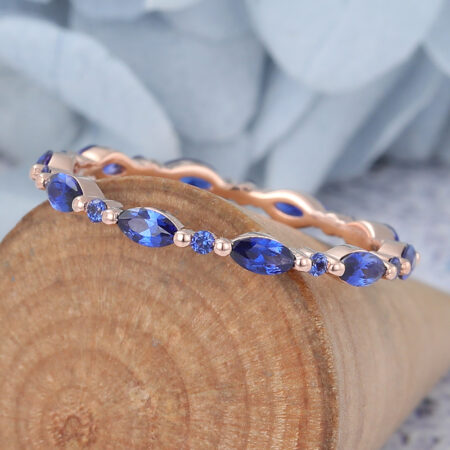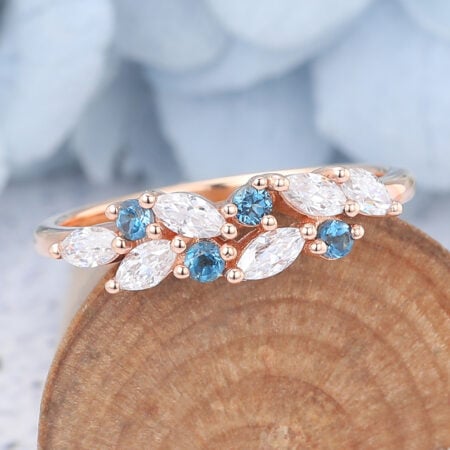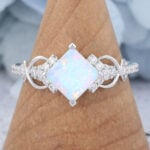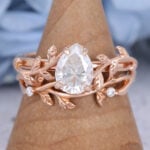How To Tell If A Sapphire Is Real: 5 Easy Ways To Spot A Genuine Sapphire
Sapphire is one of the Big Three colored precious gemstones—along with ruby and emerald—that have fascinated collectors and jewelry lovers for centuries. Known for its deep blue beauty and rich symbolism of wisdom, loyalty, and protection, sapphire remains a timeless favorite. However, with lab-created and imitation sapphire stones becoming increasingly common, knowing how to tell if a sapphire is real is essential for anyone looking to purchase or verify fine jewelry. This guide will walk you through clear, reliable methods to identify an authentic sapphire with confidence.
What Are Sapphires?
Sapphire is a gemstone known for its hardness and wear resistance. Its chemical composition is aluminum oxide (Al2O3), which belongs to the mineral corundum. Its Mohs hardness is as high as 9, second only to diamond (10), which makes sapphire very suitable for daily wear, especially for high-contact accessories such as rings and bracelets. Sapphire is most well-known for its deep blue color, which comes from the interference of internal trace elements. In addition to its attractive appearance, sapphire also symbolizes wisdom, loyalty and truth. It has both visual beauty and spiritual significance.
Types of Sapphire
Types of Sapphire by Origin
Natural Sapphire: Naturally grown in the earth’s crust, sapphire with natural inclusions is unique and collectible.
Lab-grown Sapphire: Sapphire grown in a laboratory to simulate natural conditions, with the same composition and structure as natural sapphire. But it is purer and cheaper, making it an environmentally friendly and ethical choice.
Simulated Sapphire: Artificial materials that only look like sapphire, such as blue glass or cubic zirconia. The chemical composition is completely different from sapphire, the price is cheap, and it is easy to be confused.
Types of Sapphire by Variety
Blue Sapphire: The most classic variety of sapphire, with a blue hue given by iron and titanium. Sapphire engagement rings and high-end jewelry are popular.
Padparadscha Sapphir: A rare pink-orange sapphire named after the lotus flower. Highly collectible and expensive.
Color-Changing Sapphire: Two colors under different light sources (such as blue under daylight and purple under incandescent light). The change is obvious and the rarity is high.
Star Sapphire: The inclusions are arranged neatly, and when illuminated, it can show a six-ray or twelve-ray starlight effect (called the “starlight” phenomenon). It is mostly used in men’s rings or special jewelry.
Fancy Color Sapphire: All colors except blue, such as pink, yellow, green, purple, black, etc. The colors come from different trace elements, and the colors are rich and unique.
Where Is Sapphire From?
Characteristics Of A Real Sapphire
An authentic sapphire displays a range of natural characteristics that distinguish it from synthetic sapphires and imitation stones. Visually, its color is rarely perfectly uniform; natural sapphires often feature subtle zoning or soft color bands that enhance their depth and uniqueness. The hardness of sapphire on the Mohs scale is 9, which makes it highly durable and well-suited for everyday wear.
Under magnification, true sapphires typically reveal fine inclusions—such as needle-like or feather-like formations—that offer further evidence of their natural origin. Adding to their distinctiveness, genuine sapphires exhibit strong single refraction, resulting in a rich, velvety luster that feels refined rather than overly flashy.

How To Tell If A Sapphire Is Real?
Appearance color
True sapphire color is deep and natural, with rich layering, the blue is evenly distributed but not monotonous, and subtle color bands or gradients are common, showing the characteristics of natural formation. In contrast, fake sapphires are usually too bright or single in color, lack natural color changes, and are often dyed glass or plastic, and the color appears unreal or dark.
Hardness test
Natural sapphire has a Mohs hardness of up to 9, which is an extremely hard gemstone, second only to diamond. When scratching its surface with a steel knife or glass, it usually does not leave scratches, and the surface is strong and wear-resistant. Fake sapphires such as glass or plastic have lower hardness and are easily scratched or scratched.
Inclusion observation
Real natural sapphire stone often contains irregular needle-shaped or cloud-like inclusions. These natural “fingerprints” are natural in shape and randomly distributed. Although synthetic sapphires are composed of corundum, the inclusions in synthetic sapphire are mostly parallel bubbles or feather patterns, with regular structure and artificial traces. Fake sapphires (such as glass) usually have no inclusions, or only contain bubbles and cracks, which can be easily identified through a magnifying glass to distinguish between natural, synthetic and imitation products.
Optical properties
The refractive index of natural sapphires is about 1.76-1.77, with obvious birefringence effect, and the color is bright and evenly distributed when light passes through. When observed with a polarizing lens, a unique optical reaction can be seen. Fake sapphires have a low or unstable refractive index, lack birefringence, and the light is blurred and irregular, which is more obvious under professional optical instruments.
Weight and density
The density of natural sapphires is about 4.0 g/cm3, which is significantly higher than glass (about 2.5 g/cm3) and plastic, so they feel heavy under the same volume. Fake sapphires are mostly made of low-density materials, lighter in weight and lighter in feel. Weighing and hand feel comparison can assist in the preliminary judgment of the authenticity of gemstones.
Professional testing
The chemical composition and physical properties of gemstones can be accurately analyzed through professional testing by authoritative organizations such as GIA or IGI. Real sapphires are made of corundum, and their inclusions and optical characteristics meet natural standards. Fake sapphires have obvious differences in composition, inclusions and optical properties. The test report will clearly mark whether they are real or fake and whether they are synthetic, which is the most reliable way to identify them.
Why It’s Hard to identify Real Sapphire vs Fake?
Because both synthetic and imitation sapphires can closely mimic the appearance of natural ones, knowing how to tell if a sapphire is real is not always straightforward. Lab-created sapphires share the same chemical composition as real ones, while glass or cubic zirconia can be colored to look convincingly similar. Differences in inclusions, hardness, or light refraction are often subtle and invisible to the naked eye, making professional tools or expertise essential. That’s why identifying a real sapphire from a fake can be especially challenging for untrained buyers.
Lab Sapphire vs. Natural: Key Differences
Different formation methods: Natural sapphires are formed by natural geological processes, while laboratory sapphires are synthesized by artificial high-temperature processes.
Different inclusion characteristics: Natural sapphires contain irregular inclusions, while synthetic sapphires often have regular or curved inclusions.
Appearance and color: Natural sapphires have natural layers of color, while laboratory sapphires usually have uniform and nearly perfect color.
Rarity and value: Natural sapphires are scarce and valuable, while synthetic sapphires are more common and more affordable.
Environmental protection and sustainability: Laboratory sapphires have little impact on the environment and are more in line with modern environmental protection concepts.
Testing and certificates: Formal certificates can indicate whether sapphires are natural or synthetic, helping consumers to identify the source.
Summary: Real sapphires and lab sapphires have little difference in chemical composition and physical properties. Lab sapphires are real sapphires, and they also have the advantages of affordable prices, environmental sustainability, and transparent sources.

Market Value: Why Authenticity Matters
Real natural sapphires have a higher investment and collection value in the jewelry market because of their long formation process, scarce resources, and difficulty in mining. In particular, natural sapphires that have not been heated, have high-quality color and clarity can cost thousands or even tens of thousands of dollars each in auction houses or high-end jewelry markets.
In contrast, although laboratory-synthesized sapphires look similar and even have more perfect color, they can be mass-produced and have sufficient market supply, so their prices are usually only a fraction of natural sapphires, and their collection value is relatively low. Imitation sapphires (such as stained glass or cubic zirconia) have no gem-grade value and are basically sold only as decorations.
When and Why to Get a Sapphire Appraised?
When buying, inheriting, selling or insuring sapphires, it is important to have a professional appraisal. Appraisal can confirm the authenticity of the sapphire, whether it has been heated or otherwise treated, the quality grade and the market value, so as to avoid paying a high price or being cheated due to lack of transparency. At the same time, insurance companies usually require an appraisal report to protect the rights of claims. Professional appraisal can also help sellers accurately assess the value of sapphires and ensure fair transactions.
Conclusion
Knowing how to tell if a sapphire is real helps you avoid fakes and make confident purchases. By checking color, hardness, inclusions, weight, and using professional tests, you can easily identify genuine sapphires with accuracy and peace of mind. Shop reliable real gemstone jewelry at Amandafinejewelry now!
Also Read: Is Lab Grown Sapphire Real Sapphire or Just Imitation?
Tanzanite vs Sapphire–What’s the Difference and Which Is Better for You?
Emerald vs Sapphire: Which Gemstone Wins in Color, Strength & Value?
FAQs About How To Tell If A Sapphire Is Real
How do you know if a sapphire is real?
You can tell if a sapphire is real by checking its hardness, natural inclusions, color depth, weight, and using professional gem testing tools.
What does a raw sapphire look like? How to identify raw sapphire?
Raw sapphires are rough, uncut stones with uneven surfaces and natural imperfections; they often have a duller color compared to polished sapphires.
What does a blue sapphire look like?
A blue sapphire typically shows a deep, vivid blue color with natural variations and sometimes visible inclusions under magnification.
Is a lab created sapphire real? Lab created sapphire vs real sapphire, what’s the differences?
Lab-created sapphires have the same chemical makeup as natural ones but are grown in controlled environments; natural sapphires form in nature over millions of years and have unique inclusions.
How to tell if a gemstone is real or glass?
Real gemstones are harder, heavier, and often have natural inclusions, while glass is softer, lighter, and usually free of natural inclusions or has bubbles instead.
Is sapphire a diamond? Do sapphires scratch?
Sapphire is not a diamond; the difference between sapphire and diamond lies in their composition and hardness. Diamonds are made of carbon and are the hardest mineral (Mohs 10), while sapphires are made of corundum with a hardness of 9. Sapphires can scratch most materials but are scratched by diamonds.
How Hard and how old are Sapphires?
Sapphires have a hardness of 9 on the Mohs scale, making them one of the hardest gemstones, second only to diamonds. They form naturally over millions of years deep within the Earth’s crust.
What is the value of a sapphire?
A sapphire’s value depends on factors like color, clarity, size, origin, and whether it’s natural or lab-created; high-quality natural sapphires can be very valuable, sometimes costing thousands per carat.



